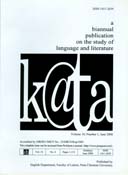The Role of Girls as Mothers in Harry Potter Series
DOI:
https://doi.org/10.9744/kata.19.1.1-7Keywords:
Myths, Girl’s role, Mother’s roles, Protectors, Nurturers, MentorsAbstract
This study focuses on the role of the female characters in Harry Potter series. It aims to find out the ways the female characters, Hermione Granger, Ginny Weasley, and Luna Lovegood take a mother role for Harry, whereas they are in their teenage years. Using Barthes’ theory on myths, this study identifies that there are two myths that are in operation, the myth that girls are supposed to be mothers and the myth that mothers are supposed to protect, nurture, and educate. As the agents of the myths,the three teenage girls willingly take their role as mothers role that are assigned to them. These three female characters take their roles as mothers to Harry in how they protect, nurture, and educate Harry. In response to this, Harry also succumbs to the position of being protected, nurtured and educated by these three girls. Despite Rowling’s claims on her being a feminist when she said that “I’ve always considered myself as a feminist” (Rowling, 2011), she cannot escape the myths on girls and women. Rowling sees that being a mother is the most powerful role for girls and womenDownloads
References
Arendell, T. (1999). Mothering and motherhood: A decade review. Working Paper No. 3April 1999. Retrieved from https://workfamily.sas.upenn.edu/sites/workfamily.sas.upenn.edu/files/imported/new/berkeley/papers/3.pdf
Barthes, R. (1972). Mythologies. New York: Noondy Press.
Baumman, A.E.M. (n.d.). Explanation of “myth today” from Roland Barthes’s mythologies. Retrieved from http://hatterscabinet.com/pdfs/aembaumann_barthes_mythologies.pdf.
Berry, W. (2011). When men are boys and wives are mothers. Retrieved from https://www.psychology-today.com/blog/the-second-noble-truth/ 201102/when-men-are-boys-and-wives-are-mothers.
Cook, J.L. & Cook, G. (2008). Child development: Principles and perspectives. (2nd e.d.). London, UK: Pearson.
Crouter, A.C., McHale, S.M., & Tucker, C.J. (1999). Family context and gender role socialization in middle childhood: Comparing girls to boys and sisters to brothers. Child Development, Vol. 70, No. 4, pp. 990-1004. Retrieved from http://www. jstor.org/stable/1132257.
Gonzalez-Mena, J. (2006). The young child in the family and the community (4th e.d.). Upper Saddle River, NJ: Pearson Merrill Prentice Hall.
Goodnow, J. (1988). Children's housework: Its nature and functions. Psychological Bulletin, 103, pp. 5-26. Retrieved fromhttp://www.jstor.org/stable/ 1132257.
Heyman, D., Barron, D., & Rowling, J.K. (Producers), & Yates D. (Director). (2011). Harry Potter and the deathly hallows. [DVD]. United States: Warner Bros. Pictures.
Iswidayati, Sri. (Ed). 2011. Roland barthes dan mithologi.
McMahon, M. (1995). Engendering motherhood: Identity and self-transformation in women's lives. New York: Guilford Press.
Meet author J.K. Rowling. (n.d.). Retrieved from http://harrypotter.scholastic.com/jk_rowling/
Nyamidie, J. K. (1999). African proverb of the month september, 1999. Retrieved from http://www.afriprov.org/african-proverb-of-the-month/25-1999proverbs/146-sep1999.html.
Potter pre-orders smash all records. (2007). Retrieved from https://www.theguardian.com/ books/2007/jul/16/harrypotter.jkjoannekathleenrowling.
Power, M. (2011). The social construction of gender. Retrieved from http://www.personal.psu.edu/bfr3/blogs/applied_social_psychology/2011/10/the-social-construction-of-gender.html.
Robinson, A. (2011, September 30). An a to z of theory Roland Barthes’s mythologies: A critical theory of myths. Retrieved from https://ceasefiremagazine.co.uk/in-theory-barthes-2/
Rowling, J.K. (1997). Harry potter and the sorcerer’s stone. London, UK: Bloomsbury.
Rowling, J.K. (1998). Harry potter and the chamber of secrets. London, UK: Bloomsbury.
Rowling, J.K. (2000). Harry potter and the goblet of fire. London, UK: Bloomsbury.
Rowling, J.K. (2003). Harry potter and the order of phoenix. London, UK: Bloomsbury.
Rowling, J.K. (2007). Harry potter and the deathly hallows. London, UK: Bloomsbury.
Tarlow, B. (1996). Caring: A negotiated process that varies. In S. Gordon, P. Benner, & N. Noddings (Eds.), Caregiving: Readings in knowledge, practice, ethics, and politics (pp. 56-82). Philadelphia, PA: University of Pennsylvania Press.
Downloads
Published
How to Cite
Issue
Section
License
![]() This work is licensed under a Creative Commons Attribution License
This work is licensed under a Creative Commons Attribution License



.png)
.png)

















